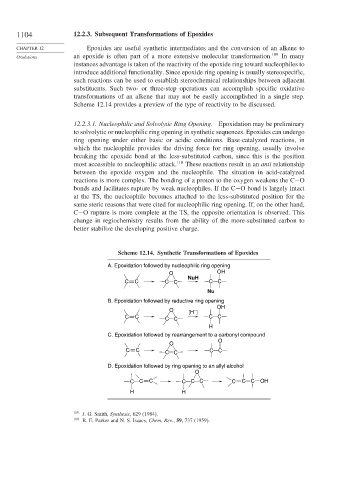Page 1128 - Advanced Organic Chemistry Part B - Reactions & Synthesis
P. 1128
1104 12.2.3. Subsequent Transformations of Epoxides
CHAPTER 12 Epoxides are useful synthetic intermediates and the conversion of an alkene to
Oxidations an epoxide is often part of a more extensive molecular transformation. 109 In many
instances advantage is taken of the reactivity of the epoxide ring toward nucleophiles to
introduce additional functionality. Since epoxide ring opening is usually stereospecific,
such reactions can be used to establish stereochemical relationships between adjacent
substituents. Such two- or three-step operations can accomplish specific oxidative
transformations of an alkene that may not be easily accomplished in a single step.
Scheme 12.14 provides a preview of the type of reactivity to be discussed.
12.2.3.1. Nucleophilic and Solvolytic Ring Opening. Epoxidation may be preliminary
to solvolytic or nucleophilic ring opening in synthetic sequences. Epoxides can undergo
ring opening under either basic or acidic conditions. Base-catalyzed reactions, in
which the nucleophile provides the driving force for ring opening, usually involve
breaking the epoxide bond at the less-substituted carbon, since this is the position
most accessible to nucleophilic attack. 110 These reactions result in an anti relationship
between the epoxide oxygen and the nucleophile. The situation in acid-catalyzed
reactions is more complex. The bonding of a proton to the oxygen weakens the C−O
bonds and facilitates rupture by weak nucleophiles. If the C−O bond is largely intact
at the TS, the nucleophile becomes attached to the less-substituted position for the
same steric reasons that were cited for nucleophilic ring opening. If, on the other hand,
C−O rupture is more complete at the TS, the opposite orientation is observed. This
change in regiochemistry results from the ability of the more-substituted carbon to
better stabilize the developing positive charge.
Scheme 12.14. Synthetic Transformations of Epoxides
A. Epoxidation followed by nucleophilic ring opening
O OH
NuH
C C C C C C
Nu
B. Epoxidation followed by reductive ring opening
OH
O [H ]
–
C C C C C C
H
C. Epoxidation followed by rearrangement to a carbonyl compound
O
O
C C C C
C C
D. Epoxidation followed by ring opening to an allyl alcohol
O
C C C C C C C C C OH
H H
109 J. G. Smith, Synthesis, 629 (1984).
110
R. E. Parker and N. S. Isaacs, Chem. Rev., 59, 737 (1959).

